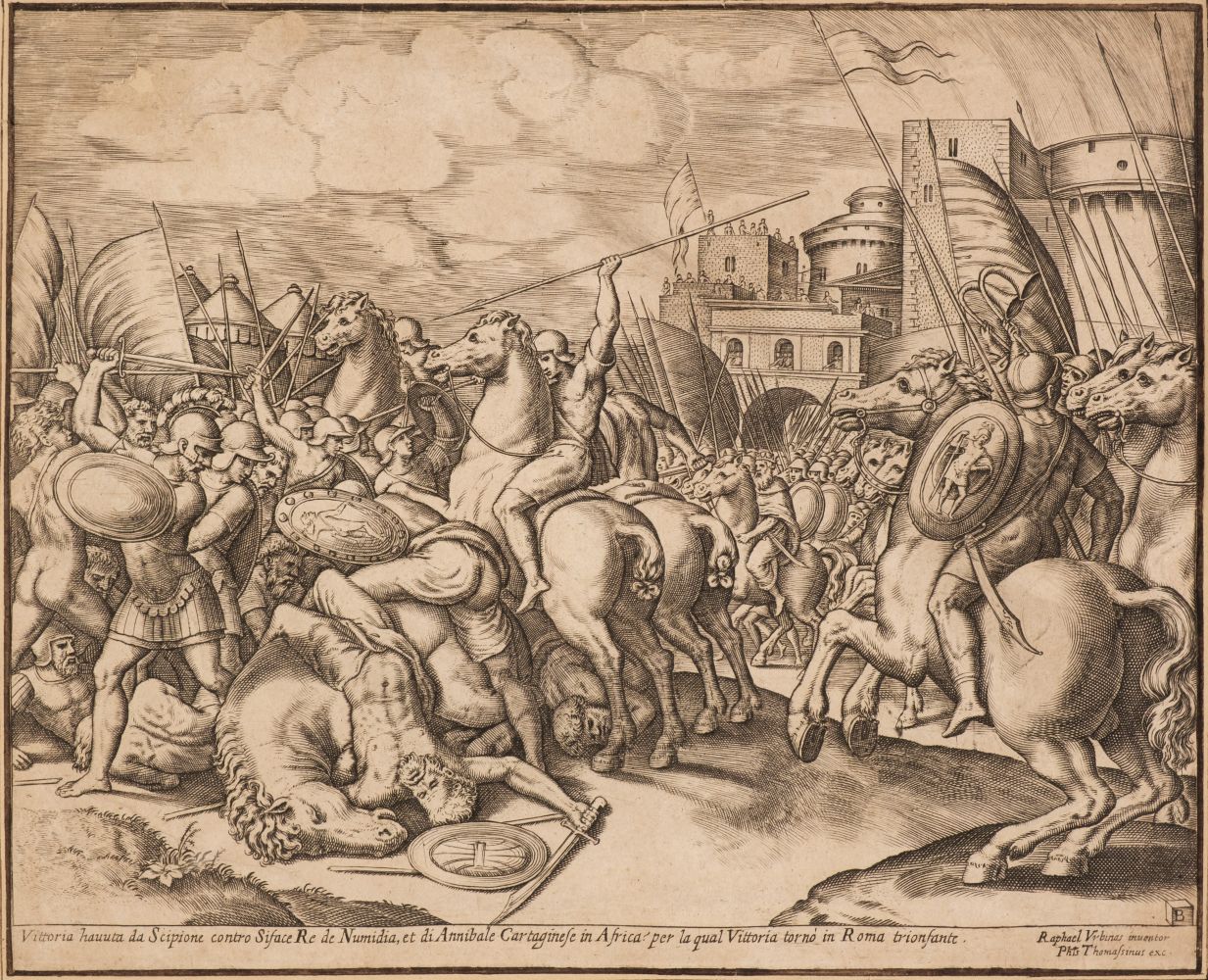MASTER OF THE DIE (fl. 1532-1550), after Raphael. [The Story of Cupid and Psyche (Bartsch 39-71)]. [Rome, ca 1535].
MASTER OF THE DIE (fl. 1532-1550), after Raphael. [The Story of Cupid and Psyche (Bartsch 39-71)]. [Rome, ca 1535]. COMPLETE set of 32 engravings, most with thread margins, each approximately 200 x 235 mm, mounted on heavy laid paper, 465 x 352 mm, and bound into an album. (Small portion of corner of pl. 11 torn, not affecting text or engraving.) 17th-century English gold-paneled and -tooled black morocco, spine gold-tooled in compartments, edges gilt. Provenance: Edward Cheney (bookplate; his collection sold Sotheby's 29 April 1885); acquired from E.P. Goldschmidt, 1970. THE COMPLETE SET OF THIS CELEBRATED SERIES OF ENGRAVINGS, first state, without the publisher's address. In the second state, the address of Antonio Salamanca has been added and the plates have been extensively retouched by Villamena. Bartsch also knew of one set of proof impressions before letters, preserved in the Vienna Imperial Library. The original designs are traditionally attributed to Raphael, and were engraved by the master known as "maestro del dado," save for three plates signed with the monogram of Agostino de Musi (called Veneziano), in the style of Marc Antonio Raimondi. Bartsch notes of the Master of the Die that "his quality of engraving comes very close to that of Marc Antonio Raimondi whose disciple he would appear to have been. In the suite illustrating the fable of Cupid and Psyche there are many engravings which equal in quality the works of that excellent engraver" (vol. XV, p. 182). Both Veneziano and the Master of the Die worked with Raphael designs frequently and despite the attributions sometimes to Michiel Coxie an Italian origin seems more likely. These engravings served as models for illustrators of Apuleius throughout the sixteenth century, and in 1802 Didot published a facsimile edition of the set with a French translation of Apuleius' text. The Italian paraphrase accompanying the plates is taken from the translation of Apuleius' works published by Boiardo in 1516.
MASTER OF THE DIE (fl. 1532-1550), after Raphael. [The Story of Cupid and Psyche (Bartsch 39-71)]. [Rome, ca 1535].
MASTER OF THE DIE (fl. 1532-1550), after Raphael. [The Story of Cupid and Psyche (Bartsch 39-71)]. [Rome, ca 1535]. COMPLETE set of 32 engravings, most with thread margins, each approximately 200 x 235 mm, mounted on heavy laid paper, 465 x 352 mm, and bound into an album. (Small portion of corner of pl. 11 torn, not affecting text or engraving.) 17th-century English gold-paneled and -tooled black morocco, spine gold-tooled in compartments, edges gilt. Provenance: Edward Cheney (bookplate; his collection sold Sotheby's 29 April 1885); acquired from E.P. Goldschmidt, 1970. THE COMPLETE SET OF THIS CELEBRATED SERIES OF ENGRAVINGS, first state, without the publisher's address. In the second state, the address of Antonio Salamanca has been added and the plates have been extensively retouched by Villamena. Bartsch also knew of one set of proof impressions before letters, preserved in the Vienna Imperial Library. The original designs are traditionally attributed to Raphael, and were engraved by the master known as "maestro del dado," save for three plates signed with the monogram of Agostino de Musi (called Veneziano), in the style of Marc Antonio Raimondi. Bartsch notes of the Master of the Die that "his quality of engraving comes very close to that of Marc Antonio Raimondi whose disciple he would appear to have been. In the suite illustrating the fable of Cupid and Psyche there are many engravings which equal in quality the works of that excellent engraver" (vol. XV, p. 182). Both Veneziano and the Master of the Die worked with Raphael designs frequently and despite the attributions sometimes to Michiel Coxie an Italian origin seems more likely. These engravings served as models for illustrators of Apuleius throughout the sixteenth century, and in 1802 Didot published a facsimile edition of the set with a French translation of Apuleius' text. The Italian paraphrase accompanying the plates is taken from the translation of Apuleius' works published by Boiardo in 1516.










.jpg)
.jpg)



Testen Sie LotSearch und seine Premium-Features 7 Tage - ohne Kosten!
Lassen Sie sich automatisch über neue Objekte in kommenden Auktionen benachrichtigen.
Suchauftrag anlegen